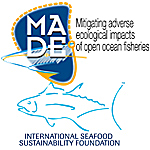The tuna fishing industry holds an important place in the Indian and Atlantic Oceans. Considering complementary data collected by the captains of the French tuna purse seine fleet (1980-2011, AVDTH database) and scientific observers (1995-2011, ObServe database), we studied the relationship between fleet, whale sharks and marine mammals. These large marine organisms are indeed observed during activities and are sometimes encircled with the net when fishing tuna schools. The purpose of this study is to analyze the spatio-temporal distribution (season and year) of co-occurrence frequency between fishing activities and these large marine organisms, and the possible impact on their mortality. Distribution maps of activities and organisms, supported by multivariate data analysis (PCA), were performed. The results highlight a seasonal and annual variability in the distribution of activities and observations. Areas of aggregations of organisms and specific seasons were highlighted, certainly in relation to structuring environmental parameters. 96% of the whale shark sightings (AVDTH) were associated with fishing activity, and 25% (ObServe) to catches, which is particularly important in comparison to marine mammal sightings (respectively 76% and 6%). No particular association between fishing and dolphins was observed in contrast to the situation known in the Pacific Ocean. The impact of fishing on the mortality of whale sharks and mammals is extremely low, even zero depending the organism, in the studied oceans. The nature and abundance of the data used provide a unique vision of these organisms distribution and fishing activities
- Presentation

 PDF version
PDF version
